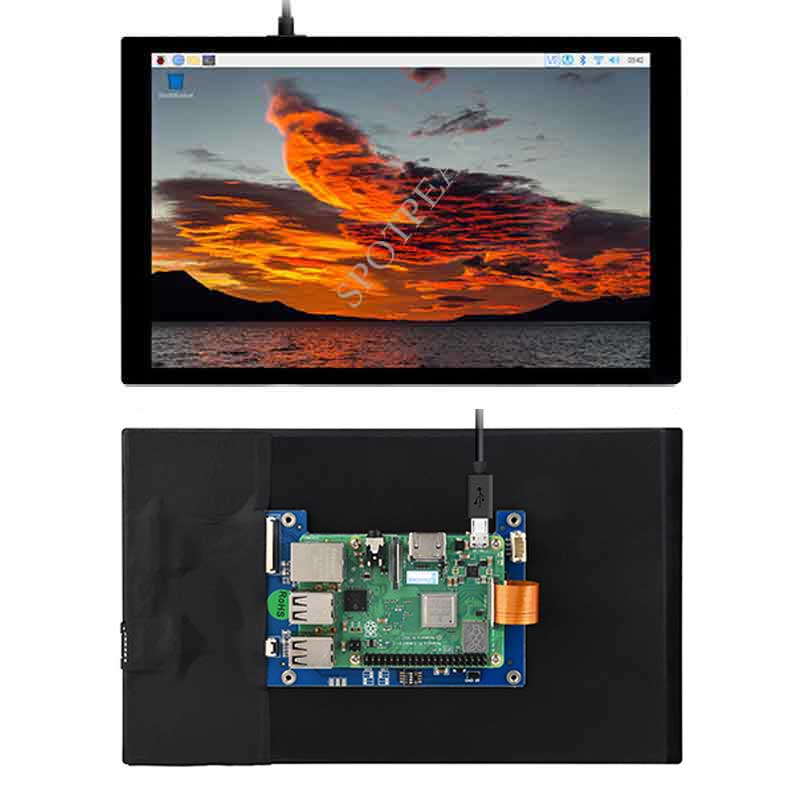- sales/support
Google Chat: zj734465502@gmail.com
- sales
+86-0755-88291180
- sales01
sales@spotpear.com
- sales02
dragon_manager@163.com
- support
tech-support@spotpear.com
- CEO-Complaints
zhoujie@spotpear.com
- sales/support
WhatsApp:13246739196
Raspberry Pi 10.1inch DSI LCD (C) User Guide
Feature
- 10.1-inch IPS capacitive touch screen with a hardware resolution of 1280 x 800
- Adopts optical bonding technique, clearer imaging
- Support 10-point capacitive touch control, tempered glass touch panel with 6H hardness
- Can be directly connected to the LCD by the DSI interface of the Raspberry Pi, and its refreshing rate is up to 60Hz
- When working with Raspberry Pi, we provide the Raspberry Pi OS system driver
- Support Pi 4B/3B+/3A+, CM3+/4 should work with DSI cable
- Support backlight adjusted by software
Working With Raspberry Pi
Hardware Connection
Method 1: Back Lock Installation
1. Connect the DSI interface of the LCD to the DSI interface of the Raspberry Pi board.
2. The Raspberry Pi is installed on the display board with the back facing down, and the 5V power supply and I2C communication are connected through the 4PIN.
The Raspberry Pi 4B back lock installation effect is as follows:
Method 2: Flat Connection
1. Use a 15PIN FPC cable to connect the DSI interface of the display to the DSI interface of the Raspberry Pi board.
2. Using a USB cable, connect the USB port of the Raspberry Pi to the Type-C port on the display baseboard.
The Raspberry Pi 4B flat installation effect is as follows: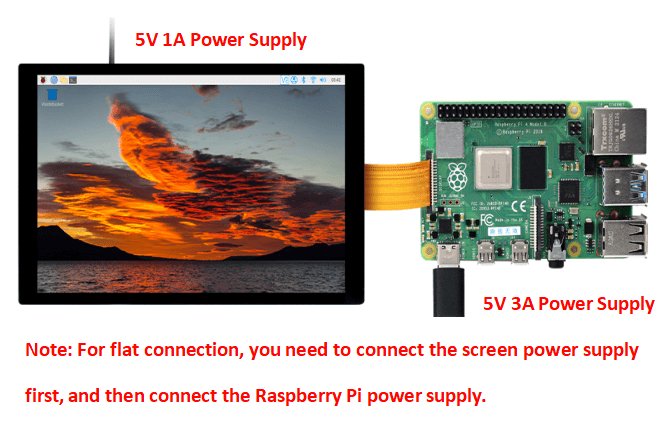
The CM4 IO Board flat installation effect is as follows:(Use DSI1 interface)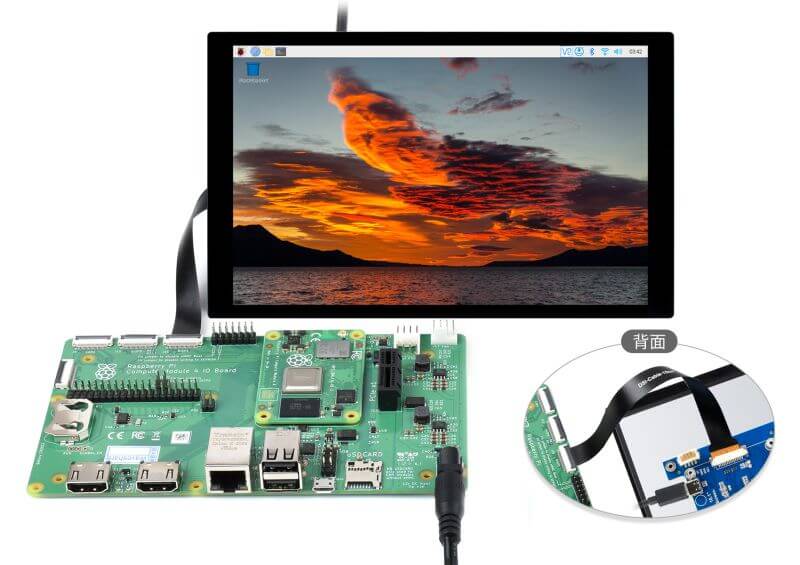
Software Setting
Method 1: Install Manually
- Download the image of the newest version Raspberry Pi, download the compressed file to the PC and extract the .img file.
- Connect TF card to PC, use SDFormatter to format TF card.
- Open Win32DiskImager software, select the system image prepared in step 1 and click write to burn the system image.
- After the programming is completed, connect the TF card to the Raspberry Pi, start the Raspberry Pi, and log in to the terminal of the Raspberry Pi (you can connect the Raspberry Pi to an HDMI display or log in remotely with ssh).
#Step 1: Download and enter the Waveshare-DSI-LCD driver folder
git clone https://github.com/waveshare/Waveshare-DSI-LCD
cd Waveshare-DSI-LCD
#Step 2: Enter uname -a in the terminal to view the kernel version and cd to the corresponding file directory
#5.15.61 then run the following command
cd 5.15.61
#Step 3: Please check the bits of your system, enter the 32 directory for 32-bit systems, and enter the 64 directory for 64-bit systems
cd 32
#cd 64
#Step 4: Enter your corresponding model command to install the driver, pay attention to the selection of the I2C DIP switch
#10.1inch DSI LCD (C) 1280×800 driver:
sudo bash ./WS_xinchDSI_MAIN.sh 101C I2C0
#Step 5: Wait for a few seconds, when the driver installation is complete and no error is prompted, restart and load the DSI driver and it can be used normally
sudo rebootNote: The above steps need to ensure that the Raspberry Pi can be connected to the Internet normally.
5. Wait for the system to restart, it will be able to display and touch normally.
Method 2: Program Pre-installed Image
- Download the 10.1inch DSI LCD - Pi4 pre-installed image and unzip to get ".img" file.
- Connect the TF card to the PC and use SDFormatter to format the TF card.
- Open Win32DiskImager software, choose the image and click "write" to program the system image.
- After programming, you can connect the TF card to the Raspberry Pi and then boot it. Just wait for about 30 seconds to display and touch.
Rotation
Method 1: Graphical Interface Rotation
In the start menu, select: Preferences->Screen Configuration->Configure->Screens->DSI-1->Orientation, select the corresponding angle in it, click "√", select Yes, and restart.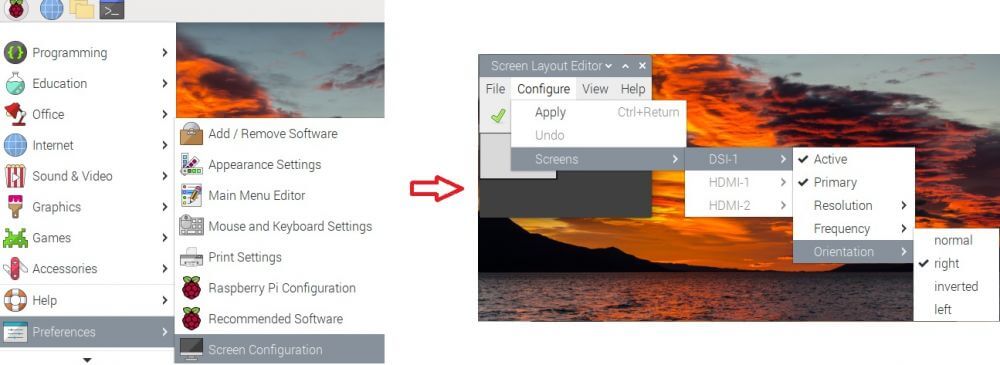
Method 2: Rotation Display In Lite Version
sudo nano /boot/cmdline.txt #Add a command corresponding to the display rotation angle at the beginning of the cmdline.txt file, save it and restart it to take effect #display rotated 90 degrees video=DSI-1:1280x800M@60,rotate=90 #display rotated 180 degrees video=DSI-1:1280x800M@60,rotate=180 #display rotated 270 degrees video=DSI-1:1280x800M@60,rotate=270
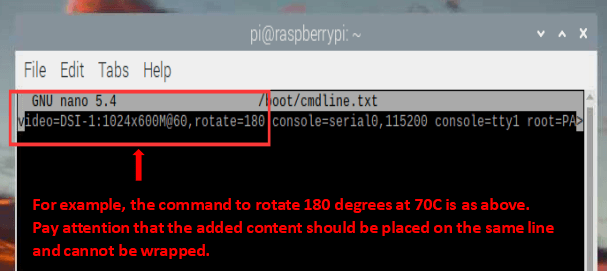
Touch To Rotate
sudo nano /boot/config.txt #Modify the instruction of the touch rotation angle at the end of the config.txt file, and it will take effect after restarting (there is a 0° touch direction instruction by default) #0°: dtoverlay=WS_xinchDSI_Touch,invertedx,swappedxy #90°: dtoverlay=WS_xinchDSI_Touch,invertedx,invertedy #180°: dtoverlay=WS_xinchDSI_Touch,invertedy,swappedxy #270°: dtoverlay=WS_xinchDSI_Touch
Backlight Control
Method 1: Graphical Interface Dimming
Using the application provided by Waveshare:
cd Waveshare-DSI-LCD # Determine the currently used kernel version, such as the 5.15.61 kernel, and run the following command cd 5.15.61 #Check the bits of the system, the 32-bit system enters 32 directory, the 64-bit system enters 64 directory cd 32 #cd 64 cd Backlight sudo ./install.sh
After the installation is complete, you can open the program in the Start menu - > Accessories - > Brightness, as shown below: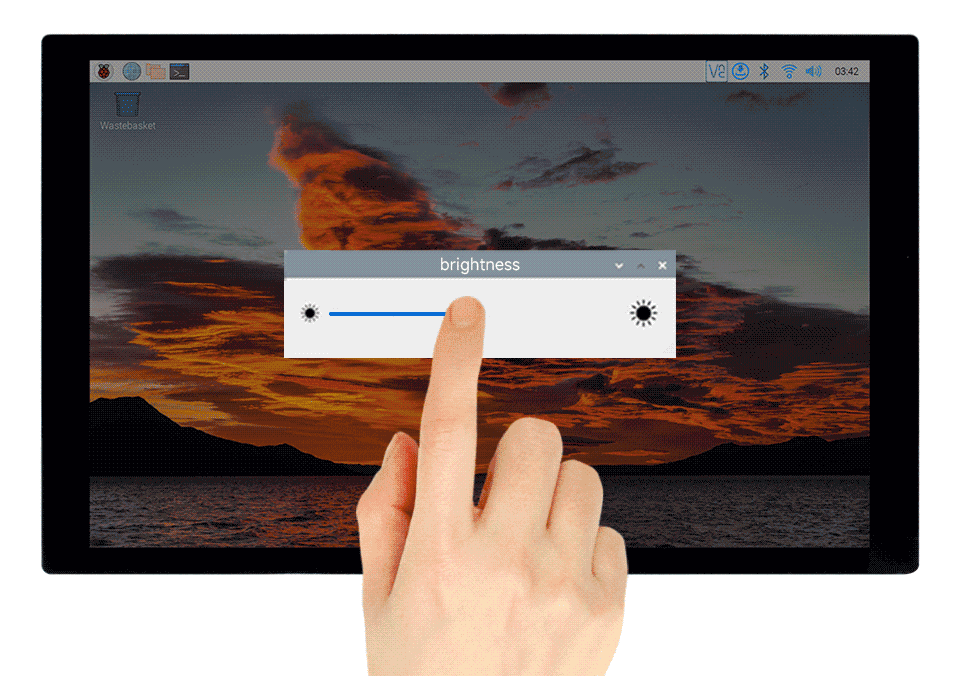
Method 2: Lite Version Dimming Command
To adjust the system command of the lite version, after entering the root privilege, execute the following command on the Raspberry Pi terminal:
echo X > /sys/waveshare/rpi_backlight/brightness
(X value in the range of 0~255)
For example:
sudo su root echo 100 > /sys/waveshare/rpi_backlight/brightness
Disable Touching
At the end of the config.txt file, add the following commands corresponding to disabling touch (the config file is located in the root directory of the TF card, and can also be accessed through the command: sudo nano /boot/config.txt):
disable_touchscreen=1
Note: After adding the command, it needs to be restarted to take effect.
Notes
1. Update the system
sudo apt-get update sudo apt-get full-upgrade
After updating the system, some files of the originally installed driver will be overwritten, in this case the driver needs to be reinstalled to display normally.
2. Replace the motherboard
If the driver was originally installed on Raspberry Pi 4 Model B, the user replaces the motherboard, such as modifying it to Raspberry Pi 3 Model B+, which will cause the display to fail to display normally. Because Pi4 and Pi3 need to load different driver files.
In this case, the driver needs to be reinstalled on the new motherboard to display normally.




